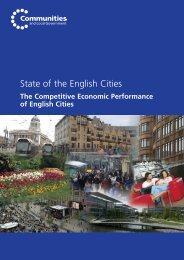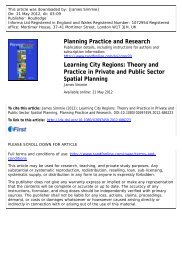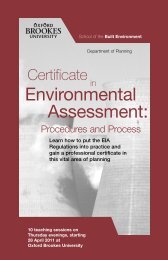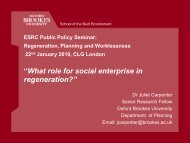History Matters: Path dependence and innovation in British city ...
History Matters: Path dependence and innovation in British city ...
History Matters: Path dependence and innovation in British city ...
You also want an ePaper? Increase the reach of your titles
YUMPU automatically turns print PDFs into web optimized ePapers that Google loves.
Figure 15: New firm formation <strong>in</strong> selected cities 1980-2005<br />
18<br />
16<br />
14<br />
12<br />
Annual VAT<br />
registrations<br />
as percentage<br />
of start of<br />
year stock<br />
10<br />
8<br />
6<br />
4<br />
2<br />
0<br />
1980 1991<br />
2005<br />
Years<br />
Read<strong>in</strong>g Leeds Oxford Aldershot Cambridge<br />
Northampton Warr<strong>in</strong>gton Great Brita<strong>in</strong><br />
Newport<br />
Swansea Wakefield Norwich Middlesbrough<br />
<strong>city</strong>-regional economy. Much of this capa<strong>city</strong><br />
is based on the creativity <strong>and</strong> R&D of exist<strong>in</strong>g<br />
medium <strong>and</strong> large firms. Nevertheless, a<br />
significant proportion of new ideas are<br />
commercialised by new small firms. Figure 15<br />
exam<strong>in</strong>es the rates of new firm formation <strong>in</strong> our<br />
sample cities. While average new firm formation<br />
fell across Brita<strong>in</strong> dur<strong>in</strong>g the 1990s, it is<br />
noteworthy that some of our more <strong>in</strong>novative<br />
<strong>city</strong> economies such as Aldershot, Cambridge<br />
<strong>and</strong> Oxford saw even lower numbers of new<br />
firms. This may <strong>in</strong>dicate some loss of dynamism<br />
<strong>in</strong> these economies.<br />
Conversely it is also <strong>in</strong>terest<strong>in</strong>g to note the<br />
slightly above average rates of new firm<br />
formation <strong>in</strong> some of our less <strong>in</strong>novative<br />
cities such as Wakefield, Newport <strong>and</strong><br />
Middlesbrough. Although the rate is now<br />
decl<strong>in</strong><strong>in</strong>g, this may <strong>in</strong>dicate that the “gales<br />
of creative destruction”, to use Schumpeter’s<br />
famous phrase (Schumpeter 1939),<br />
experienced by their traditional <strong>in</strong>dustries may<br />
have given local entrepreneurs the <strong>in</strong>centive<br />
to start new firms – partly because of a lack of<br />
alternative employment options.<br />
Heterogeneity <strong>and</strong> diversity<br />
There has been a long-runn<strong>in</strong>g debate about<br />
whether economic growth <strong>and</strong> the creation<br />
of new pathways are driven by heterogeneity<br />
<strong>and</strong> diversity or by specialisation. The question<br />
is whether urban economic specialisation<br />
or diversification is more likely to produce<br />
the external economies associated with the<br />
localised spillover of technology <strong>and</strong> the<br />
promotion of local <strong><strong>in</strong>novation</strong>. Marshall’s<br />
(Marshall 1890) orig<strong>in</strong>al theory of localisation<br />
economies, developed subsequently by<br />
Arrow (Arrow 1962) <strong>and</strong> Romer (Romer<br />
1990) (known as MAR), focused on the<br />
benefits of local <strong>in</strong>dustrial specialisation, <strong>and</strong><br />
this has been carried <strong>in</strong>to much of the ‘new<br />
economic geography’ theory, <strong>and</strong> to Porter’s<br />
cluster theory. This contrasts with the work<br />
of Jane Jacobs (Jacobs 1969) who argued<br />
that the more diverse a <strong>city</strong>’s economy, the<br />
more general the external economies of<br />
agglomeration, the more the scope for varied<br />
<strong>in</strong>teractions between firms <strong>and</strong> the more likely<br />
spontaneous <strong><strong>in</strong>novation</strong> will occur. She also<br />
held, conversely, that the more economically<br />
specialised a <strong>city</strong> is, the more prone it is<br />
32













